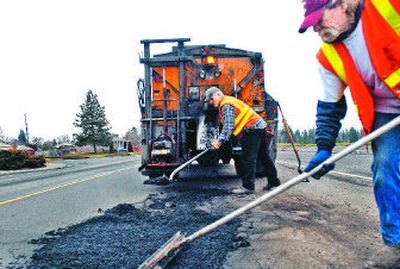Area roads sinking fast

Some Spokane and Spokane Valley streets are so bad that when the winter thaw arrives, the pavement doesn’t just develop a few potholes – entire sections give up the ghost.
Neil Kersten, public works director in Spokane Valley, said heavier rains last fall combined with an extended freeze this winter to aggravate the perennial damage, mainly on older roads.
“It was kind of a tough winter with the hard freezing,” he said.
In North Idaho, crews are reporting that the annual eruption of potholes is under way but apparently not as severe.
Spokane Falls Boulevard next to the INB Performing Arts Center crumbled to pieces last week. In Spokane Valley, Evergreen Road between 24th and 32nd avenues turned into more of a driver’s minefield.
Spokane Falls Boulevard got temporary repairs last Saturday.
“We use the expression, ‘Blew up on us,’ ” said Scott Egger, Spokane streets director. “It basically disintegrated on us.”
On Spokane’s North Post Street, East Empire Avenue and North Alberta Street large sections of pavement are failing. “We have those mud boils opening up all over the city,” Egger said.
As bad as it looks on some streets, this year’s pothole season is similar to that of previous years, Egger said.
In Coeur d’Alene, workers are receiving two to three pothole reports a day but are keeping up, said Jim Wuest, assistant street superintendent.
In Kootenai County’s road district out of Post Falls, workers said they have things well under control.
Elsewhere in North Idaho, the state placed truck weight restrictions on highways on the east side of Lake Coeur d’Alene earlier this month.
Spokane’s trouble stems from prolonged heavy use, along with inadequate construction years ago. Many streets lack a sufficient base layer of gravel to allow for drainage and strength beneath the blacktop.
Potholes and mud boils came so fast that crews were reportedly running short on “cold mix” asphalt in Spokane this week. As a result, they have eased up on repairs until a new supply can be delivered. Two crews were working on smaller potholes on Wednesday.
Officials said a $117 million street repair bond issue approved by Spokane voters in 2004 was enough money to fix only about one-third of the city’s worst streets. It will take 10 years of work to fix just those streets, and then more money would be needed to continue addressing in the second half of the next decade, officials said.
The current Spokane bond issue is limited to reconstruction only, and not to amenities such as bike lanes, curbside work, sidewalk repair or devices to slow traffic in an effort to stretch the money as far as possible, as well as keep a promise to voters to use it for repairs, said Dallas Hawkins, chair of the Citizen Streets Advisory Commission.
An update on the bond work from the commission is scheduled for the Spokane City Council on Monday night.
Any work done at this time of year is considered temporary. Cold mix is relatively soft and pliable so crews will have to return during the summer and dig out cold mix patches and replace them with more permanent and harder “hot mix” patches.
Inadequate subgrade under many city streets turns soft and muddy when the overlying pavement develops cracks. That allows water to seep into it. When the underlying soil freezes, it expands and forces further breakage. Trouble erupts when the road thaws.
Last year, crews fought to fill Alberta Street from Northwest Boulevard to Wellesley Avenue until bond reconstruction can be scheduled there.
North Post Street north of Maxwell Avenue also is on the list for repairs, and it has large sections of failing pavement.